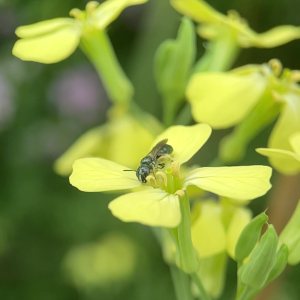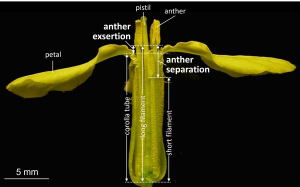 A recently published article by members of the Conner Lab at the W.K. Kellogg Biological Station provides insight into how natural selection shapes flowers using a promising new approach to studying adaptation.
A recently published article by members of the Conner Lab at the W.K. Kellogg Biological Station provides insight into how natural selection shapes flowers using a promising new approach to studying adaptation.
The article, “Strong evidence for positive and negative correlational selection revealed by recreating ancestral variation,” was published earlier this year and be featured in an upcoming Digest article in the journal Evolution.
About the study
Robin Waterman, KBS graduate student and lead author on the study, worked with lab principal investigator Jeff Conner and others to examine the relationship between traits of interest and fitness using wild radish, one of the world’s most damaging agricultural weeds.
Wrote Waterman, “Adaptation is the process by which organisms become well-suited to their environments and helps explain the incredible diversity of life. However, it can be difficult to study the process of adaptation because natural selection has already eliminated less fit forms, resulting in a limited range of trait variation in current populations.”
The study employed artificial selection—the same process used to domesticate crops or livestock—to create a wild radish population with an expanded range of variation in two traits that describe the position of the pollen-producing anthers within the flower. This relative positioning is important because it affects the efficiency of pollination. The team then placed plants from the artificially selected population into the field and measured both the floral traits and fitness (number of offspring) of each plant.
Findings
 They found that intermediate levels of anther exsertion (or, how far the long type of anther protrudes from the tube of petals) are favored, likely to allow small bees, the plant’s primary pollinators, to make better contact with the anthers. For the other trait, anther separation (the distance between the short and long type anthers) the extremes are favored, which was unexpected.
They found that intermediate levels of anther exsertion (or, how far the long type of anther protrudes from the tube of petals) are favored, likely to allow small bees, the plant’s primary pollinators, to make better contact with the anthers. For the other trait, anther separation (the distance between the short and long type anthers) the extremes are favored, which was unexpected.
According to Waterman, the latter result wasn’t easily explainable with current data, but follow-up studies are already underway to more closely examine how anther separation in wild radish affects the placement of pollen on pollinator bodies.
“When I started my Ph.D. during the pandemic,” Waterman shared, “I was lucky enough to be given access to a rich yet unpublished dataset built from the labor of prior members and collaborators of the Conner Lab.
“I am proud to honor their hard work by sharing our findings with the scientific community.”

A legacy of conservation; a commitment to sustainability.
3700 E. Gull Lake Drive
Hickory Corners, MI 49060
(269) 671-5117
info@kbs.msu.edu